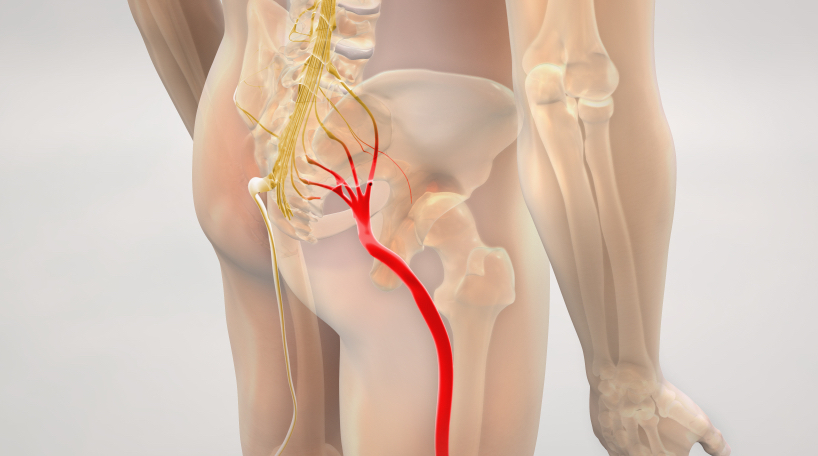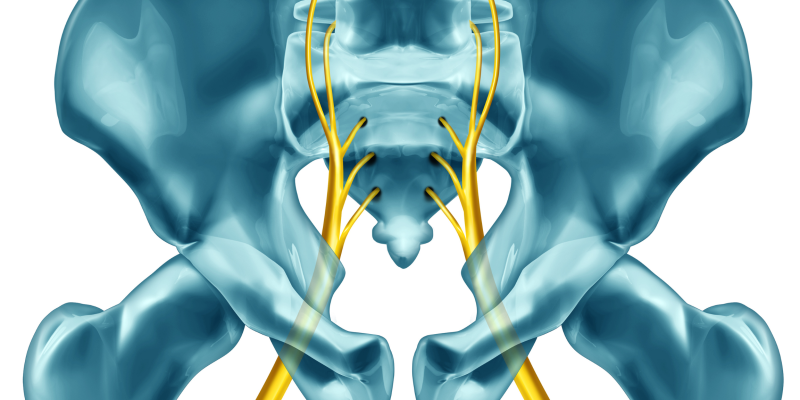What is sciatica?
Sciatica is a general name given to any pain that is caused by irritation or compression of the sciatic nerve. The sciatic nerve is the longest nerve in the body. It runs from the back of the pelvis, through the buttocks, and travels along the back of both legs, ending at your feet.

What are the causes of sciatica?
Many things can cause the sciatic nerve to become irritated however, the most common causes are:
Herniated disc – a herniated disc occurs when the outer part of the disc ruptures (splits), allowing the gel inside to bulge and protrude outwards between the vertebrae. This can press on the nerve causing sciatica or irritate the nerve by the chemicals released.
- Spinal stenosis – this is the narrowing of the nerve passages in the spine. It occurs when the bones, ligaments or discs of the spine restrict the nerves of the spine. This usually occurs in people over 40 years of age. (It is very common, and if you are 40 that doesn’t mean you will have it).
- Injury to muscles/ ligaments – This can cause swelling and inflammation around the back which can irritate the sciatic nerve. Some muscle problems can mimic sciatica.
- Piriformis syndrome – It is a condition that piriformis muscle, located in the buttock region, spasms and causes buttock pain. The piriformis muscle can also irritate the nearby sciatic nerve and cause pain, numbness and tingling along the back of the leg and into the foot (similar to sciatic pain).
Symptoms of sciatica
Sciatica is different from general back pain. The pain of sciatica usually causes a little problem to the back, however, radiates from the lower back, past the buttocks and into one or both of the legs, often as far down as the calf or foot. Sciatic pain can range from being mild to very painful and can last for weeks or months.
In many cases If you have sciatica, you may also experience the following symptoms around your legs and feet:
- Numbness around the buttocks.
- Tingling around the buttocks, and sometimes could radiate down the knee and your calves.
- Muscle weakness could happen in some cases.
Cauda equina syndrome
Cauda equina syndrome is a rare but serious condition that can cause sciatica. The cauda equina is a bundle of nerves that split from the spinal cord. Cauda equina syndrome occurs when these nerves are compressed or damaged.
One of the warning signs of (cauda equina) syndrome is suddenly or progressively losing control of your legs, or bladder/bowel. If this happens we would encourage you to seek urgent medical attention immediately.
How to treat sciatica?
Most cases of acute sciatica will pass without the need for treatment. You can follow this link and see how to treat sciatica at home. This advice and usually help relieve the symptoms. However, for persistent sciatica, you may be advised to try a structured exercise program under the supervision of your Physical Therapist.
Our Approach
Dublin Sports Injury Clinic is a Physical Therapy Clinic based in Fitzwilliam Square, Dublin2. We have a high volume of patients who are treated with low back pain. Initially, our treatment will be focusing on helping our patients to get pain free as quickly as possible. We educate our patients to understand the cause of their back pain and how they can stay pain-free. Our treatment and rehabilitation exercises will be customized for every patient and we show them the correct techniques and progression.
Next step
Want to get in touch with our team of a therapist or you are looking for some advice? Simply fill in your details below & we get in touch with you shortly.
Disclaimer: This article is for information only and should not be used for the diagnosis or treatment of medical conditions. You can contact us if you would like to book an appointment or get some advice from our therapist.
References: Check here

One Response
Thank you for sharing this, really find them helpful. I’m doing this routine 2times a day, and it helped a lot. Appreciate your help.